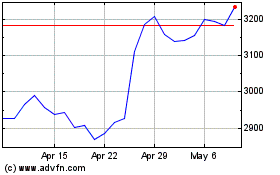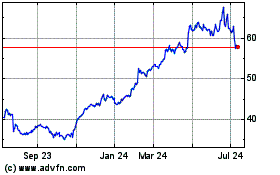By Ellie Ismailidou and Victor Reklaitis, MarketWatch
Dovish Fed speakers, weak data boost sentiment; market shrugs
off drop in oil prices
U.S. stocks pared sharp opening losses to finish nearly
unchanged on Monday, breaking the weeks-long correlation with oil
prices.
The main indexes briefly turned positive after a late-afternoon
rally, but finished roughly flat, despite a 6% drop in oil .
The S&P 500 closed less than a point lower, or less than
0.1%, at 1,939. The Dow Jones Industrial Average reversed a
160-point loss to close 17.12 points, or 0.1%, lower at 16,449.
Meanwhile, the Nasdaq Composite outperformed other indexes and
ended the day up 6.41 points, or 0.1%, at 4,620.
Wall Street opened deep in negative territory on Monday, with
sentiment hit by renewed declines in oil futures,
(http://www.marketwatch.com/story/oil-sags-on-china-data-production-cut-doubts-2016-02-01)
following a 4.4% gain last week, amid fresh signs of sluggishness
in China's economy
(http://www.marketwatch.com/story/china-manufacturing-numbers-indicate-sluggishness-2016-01-31)and
dimming prospects of a coordinated oil production cut by key
producers.
But sentiment for stocks shifted after weak U.S. manufacturing
data were taken as an indication that the Federal Reserve will hold
off on its plans to raise interest rates later this year.
The stock rally gained steam after Fed Vice Chairman Stanley
Fischer suggested the market's expectations of barely any interest
rate increases this year could turn out to be right
(http://www.marketwatch.com/story/feds-fischer-says-markets-might-be-right-after-all-2016-02-01).
Last month, Fischer was more hawkish, saying that the Fed thought
the market expectations, at the time, for two rate increases in
2016 were "too low."
"[Fischer] has always been on the hawkish side. So the fact that
he made these comments has even more significance for the market,"
said Kent Engelke, chief economic strategist at Capitol Securities
Management. The comments, along with the sluggish manufacturing
data helped "turn the market," Engelke added.
U.S. manufacturing activity contracted for the fourth straight
month
(http://www.marketwatch.com/story/weak-tone-to-manufacturing-report-from-ism-in-january-2016-02-01),
albeit at a slower pace in January than economists' expectations.
The Institute for Supply Management said its manufacturing index
rose to 48.2% in January from 48%, above forecasts but still below
the reading of 50% that signals expansion.
The PCE index, the Fed's preferred inflation gauge, fell 0.1% in
December and 1.4% over the past 12 months, remaining well below the
Fed's 2% target
(http://www.marketwatch.com/story/consumer-spending-goes-nowhere-in-december-2016-02-01).
"The lack of inflationary pressure in the PCE deflator measures
of prices is another reason why the Fed could stand pat in March,"
said Paul Ashworth, chief U.S. economist at Capital Economics, in a
note.
The volatility and mixed reactions following the soft data
showed that "a lot of investors are confused, and understandably
so," said Diane Jaffee, a portfolio manager at TCW.
"We haven't been in a normal-interest-rate environment since the
crisis," Jaffee said. She compared the Fed's stance toward market
volatility to a parent helping a toddler get on his feet. "As the
baby takes steps and stumbles, you don't know whether to rush to
hold them up or let them keep walking."
The market-implied probability of a rate increase in March was
at 14% Monday afternoon, down from 21% late morning, according to
the CME Group's FedWatch tool
(http://www.cmegroup.com/trading/interest-rates/countdown-to-fomc.html)that
tracks Fed-fund futures prices.
Also read:Wall Street sees shrinking likelihood of any rate
increase in 2016
(http://www.marketwatch.com/story/wall-street-sees-shrinking-likelihood-of-any-rate-hike-in-2016-2016-01-29)
The energy sector was the worst performer on the S&P 500
Monday, down 1.9% on the day, followed by financials, down 0.6%.
Energy names were among the worst performers on the Dow
industrials, led by Exxon Mobil Corporation (XOM), which closed
down 1.7%.
Read: A big reason it is too late for OPEC to cut production
(http://www.marketwatch.com/story/a-big-reason-its-too-late-for-opec-to-cut-production-2016-02-01)
Google parent Alphabet Inc. (GOOGL) (GOOGL)reported after the
bell
(http://www.marketwatch.com/story/alphabet-stock-surges-on-huge-google-earnings-beat-2016-02-01).
Investors were awaiting a report from toy maker Mattel (MAT).
Read more: Earnings may lift Google parent Alphabet's market
value above Apple's
(http://www.marketwatch.com/story/alphabet-earnings-could-push-google-parent-past-apple-as-worlds-most-valuable-company-2016-01-29)
Of the 207 companies that have reported so far, 142 have beat
analysts' estimates, which equates to a 69% beat rate, better than
the historic average of 66%, according to S&P Capital IQ. But
aggregate S&P 500 earnings are estimated to fall 5.87%
year-over-year.
On Friday, the S&P 500 gained 2.5%
(http://www.marketwatch.com/story/us-stocks-dow-futures-leap-after-surprise-boj-move-joining-in-global-rally-2016-01-29)
for its biggest daily gain since September, with credit going to a
surprise Bank of Japan stimulus effort. The benchmark added nearly
2% last week, yet finished down 5.1% in January.
Read: Bank of Japan's negative rate decision is a mark of
'desperation'
(http://www.marketwatch.com/story/critics-slam-bank-of-japans-negative-interest-rate-move-2016-01-29)
Other markets:Weak Chinese manufacturing data
(http://www.marketwatch.com/story/china-manufacturing-numbers-indicate-sluggishness-2016-01-31)drove
China's Shanghai Composite down by 1.8%
(http://www.marketwatch.com/story/nikkei-soars-for-second-day-following-negative-rate-cut-2016-01-31).
But Japan's Nikkei closed 2% higher, adding to its 2.8% surge on
Friday when the Bank of Japan surprised investors by pushing
interest rates into negative territory
(http://www.marketwatch.com/story/japan-follows-europe-into-negative-interest-rates-2016-01-29).
The Stoxx Europe 600
(http://www.marketwatch.com/story/european-stocks-start-february-in-the-red-as-manufacturing-data-soften-2016-02-01)
and a key dollar index lost ground, while gold futures gained.
Treasury yields inched higher, coming off a nine-month low.
Individual movers: Shares of Chipotle Mexican Grill, Inc. (CMG)
jumped 4.3% after the Centers for Disease Control and Prevention
said E. coli outbreaks "appear to be over."
(http://www.marketwatch.com/story/cdc-says-e-coli-outbreaks-at-chipotle-are-over-2016-02-01)
Aetna (AET) closed up 1.4% after the health insurer posted
better-than-expected quarterly earnings
(http://www.marketwatch.com/story/aetna-profit-jumps-more-than-forecast-in-fourth-quarter-2016-02-01)
ahead of the opening bell.
Shares in natural-gas company Questar Corp. (STR) jumped 22.5%
following news that utility company Dominion Resources Inc. (D)
plans to buy it for $4.4 billion
(http://www.marketwatch.com/story/dominion-resources-agrees-to-buy-questar-in-44-billion-deal-2016-02-01).
Dominion shares closed down 0.9%.
Economic news: Consumer spending was flat in December as
Americans mostly pocketed their income gains, the Commerce
Department said Monday. Outlays were unchanged even though incomes
rose 0.3%--consumers saved more instead. The savings rate rose to
5.5% from 5.3%, to match a three-year high.
Construction spending rose 0.1% in December
(http://www.marketwatch.com/story/construction-spending-edges-up-01-in-december-2016-02-01),
below the 0.6% gain forecast.
(END) Dow Jones Newswires
February 01, 2016 16:24 ET (21:24 GMT)
Copyright (c) 2016 Dow Jones & Company, Inc.
Chipotle Mexican Grill (NYSE:CMG)
Historical Stock Chart
From Mar 2024 to Apr 2024

Chipotle Mexican Grill (NYSE:CMG)
Historical Stock Chart
From Apr 2023 to Apr 2024
